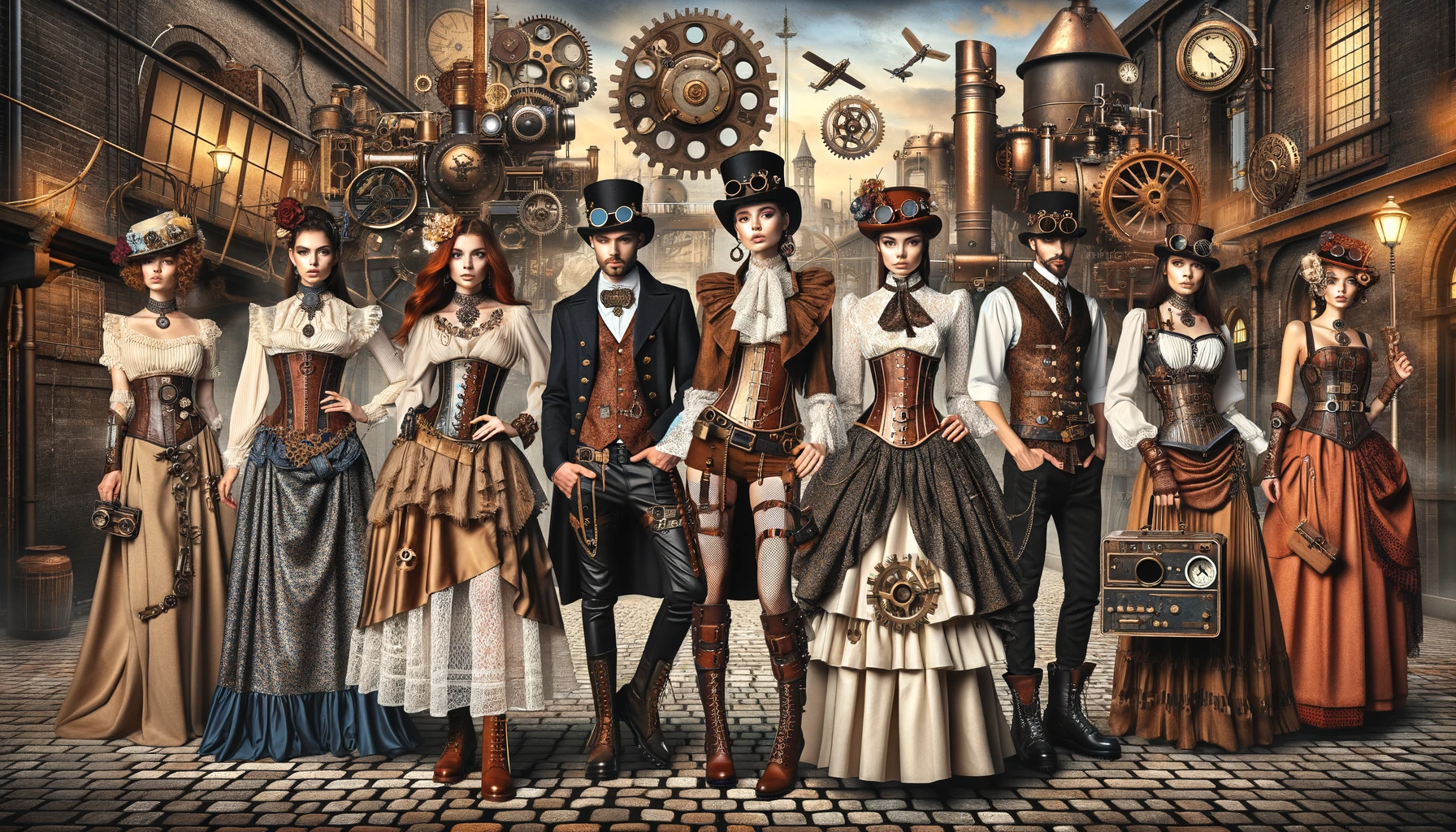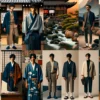From Fiction to Fashion: The Rise of Steampunk Culture
Steampunk style is a mesmerizing genre that seamlessly blends elements from the past and the future into a unique and imaginative tapestry. In the realm of Steampunk, intricate steam-powered machinery and elaborate technology of a bygone era coexist with fantastical and futuristic visions, giving rise to a captivating world of creativity. This article will delve deeper into the essence of Steampunk style and its intriguing history and development.
I. What Is Steampunk Style?
Steampunk style is a distinctive and visually captivating genre of art, design, and fashion that draws inspiration from science fiction and fantasy literature. It is characterized by its remarkable fusion of vintage aesthetics and futuristic imaginings. At its core, Steampunk envisions a parallel universe where steam-powered machinery and Victorian-era craftsmanship have evolved into advanced technology and alternate realities.

Steampunk aesthetics embrace the aesthetics of the 19th century, especially during the Industrial Revolution. This era saw the rise of steam-powered engines, mechanical inventions, and a sense of adventure that permeated literature, art, and innovation. In the Steampunk universe, this historical backdrop is reimagined, where steam-driven contraptions, intricate gears, valves, and cogs serve as the foundation for an awe-inspiring world.
II. Steampunk Fashion
Steampunk fashion is one of the most recognizable aspects of this genre. It features a wide array of clothing and accessories that reflect the Steampunk ethos, and it has become a significant subculture in its own right.

Key elements of Steampunk fashion include:
- Victorian Aesthetics: Steampunk attire often incorporates the elegant and refined clothing styles of the Victorian era, such as waistcoats, corsets, high-collared blouses, and long, flowing skirts.
- Industrial Details: The hallmark of Steampunk fashion is the incorporation of industrial elements. Goggles, gears, clockwork motifs, and brass or copper embellishments are common features, giving outfits a distinctive and mechanical look.
- Timeless Materials: Steampunk outfits are typically crafted from classic materials like leather, lace, silk, linen, and canvas. These textiles evoke a sense of vintage charm and authenticity.
- Accessories: Steampunk enthusiasts adorn themselves with an array of accessories, including top hats, bowler hats, aviator goggles, pocket watches, intricate jewelry, and leather belts adorned with pockets and pouches.
III. The History and Development of Steampunk Style
The origins of Steampunk can be traced back to the late 20th century when it emerged as a subgenre of science fiction and fantasy literature. However, it wasn’t long before this imaginative genre transcended the pages of books and started influencing various creative domains.
Early Literary Influences: The literary works of authors such as H.G. Wells and Jules Verne provided a fertile ground for Steampunk’s inception. Their stories, which often featured steam-powered machines and fantastical inventions, served as a wellspring of inspiration for the Steampunk movement.
The Difference Engine: The term “Steampunk” was popularized in 1987 by authors William Gibson and Bruce Sterling in their novel “The Difference Engine.” This groundbreaking work introduced readers to an alternate Victorian era where the computer age began in the 19th century.
The Rise of Steampunk Culture: Steampunk initially existed in the realms of literature and art but gradually expanded its influence. Artists and designers started crafting Steampunk-inspired costumes, gadgets, and artworks. It found its way into fashion, where individuals began adopting Steampunk aesthetics into their everyday wear.
Steampunk Subculture: The Steampunk subculture gained momentum as enthusiasts embraced its imaginative allure. Steampunk conventions, gatherings, and themed events started to flourish, providing a platform for like-minded individuals to showcase their creativity and passion for the genre.

Cross-Media Influence: Steampunk made its mark beyond literature and fashion. It infiltrated film, music, and video games, with iconic movies like “Wild Wild West” and video games like “Bioshock” embracing its retro-futuristic charm.
Global Popularity: Steampunk’s appeal transcended borders, becoming a global phenomenon. People from diverse backgrounds and regions embraced the style, leading to a vibrant and ever-evolving subculture.
IV. Steampunk Style Characteristics: Unveiling the Essence
Steampunk style, a captivating fusion of 19th-century aesthetics and speculative science fiction enriched by steam-powered technology, boasts a myriad of characteristic features that set it apart from other fashion genres. Let’s delve deeper into the key facets of Steampunk fashion:
1. Fabric Materials and Colors:
Steampunk revels in its unique choice of fabric materials, which serve as the canvas for its distinctive aesthetic. This genre frequently employs a range of materials, including leather, canvas, linen, lace, and satin. These fabrics are carefully selected to evoke a sense of nostalgia, vintage charm, and impeccable craftsmanship. Leather, in particular, plays a prominent role in many Steampunk outfits, exuding a rugged, yet refined, appeal.
The color palette within Steampunk fashion is equally evocative. Embracing warm and classical tones, it transports individuals to a bygone era. Predominant colors consist of various shades of brown, the rich allure of copper and brass, the enigmatic depth of black, the lush darkness of forest green, the nostalgic brick red, and the serene sophistication of navy blue. These captivating hues combine to create a timelessly appealing and visually comforting ambiance, defining the quintessential Steampunk aesthetic.

2. Style and Craftsmanship
Style: At the heart of Steampunk fashion lies an artful fusion of classical and industrial elements. The clothing styles often draw inspiration from the 19th-century fashion, featuring garments such as flared dresses, waistcoats, long coats, or trousers. It’s in the intricate details that the magic truly happens. Elements of classic machinery and steam-powered technology, such as steam pipes, valves, gears, and intricate mechanical components, are harmoniously integrated into clothing designs, culminating in the distinct and remarkable Steampunk aesthetic.
Craftsmanship: Precision and meticulous attention to detail are the cornerstones of Steampunk tailoring. Seamstresses and tailors approach their craft with an unwavering commitment to excellence. Stitching patterns can be intricate, often mirroring the aesthetics of steam machinery. These stitches are thoughtfully employed to create borders, seams, or elaborate embellishments adorning the fabric surface. The result is a tactile and visual feast for Steampunk enthusiasts.

3. Signature Patterns and Details
Leather and Reptile Skin: The use of leather and reptile skin is a common and visually striking hallmark of Steampunk fashion. Leather exudes an aura of classical robustness and distinctiveness, while reptile skin can be harnessed to craft exceptional decorative details and accessories. These materials are often used to create corsets, gloves, belts, and other accessories, adding a layer of texture and intrigue to Steampunk outfits.
Gears and Mechanical Components: Gears, steam pipes, valves, screws, fans, and an array of mechanical components adorn Steampunk attire, accessories, and even interior decor. These elements contribute to the industrial and vintage appearance, serving as iconic symbols of the Steampunk genre. Whether they are attached to belts, cuffs, or hats, they infuse a sense of wonder and fascination, showcasing the intricate machinery of an alternative era.
Floral Patterns and Vintage Motifs: While Steampunk predominantly celebrates industrial elements, it occasionally embraces the fusion of floral patterns and vintage motifs. These patterns serve to strike a harmonious balance and create focal points on Steampunk clothing and accessories. They add a touch of elegance and contrast to the otherwise mechanical and robust elements, infusing Steampunk fashion with depth and versatility.
Sharp Patterns: Crisp patterns like pinstripes, houndstooth, plaid, or herringbone may also grace Steampunk fashion, infusing style and a vintage essence. These patterns evoke a sense of refinement and formality, often seen in tailored vests, trousers, or skirts.
In the world of Steampunk, these patterns and elements can be either intricately printed or exquisitely embroidered onto fabrics. They contribute to a unique visual identity, bridging the gap between the marvels of technology and the grace of a bygone era.

4. Accessories in Steampunk Style
In the realm of Steampunk fashion, accessories play a vital role in completing the unique and vintage look associated with this distinctive style. Here, we explore the various accessories that are essential to achieve the iconic Steampunk aesthetic:
4.1. Hats and Headwear:
- Tricorn Hat: The tricorn hat, featuring three equally spaced corners, is an iconic symbol of the classical era. In Steampunk, these hats are often crafted from leather, linen, or silk and can be adorned with watch chains, gears, or other metallic details.
- Top Hat: The top hat is characterized by its tall crown and can feature decorative elements such as watch chains, gears, or steam pipes. Typically made from leather, linen, or snakeskin, the top hat exudes a classical and Steampunk-appropriate charm.
- Cylinder Hat: Resembling a large hourglass, the cylinder hat incorporates metallic components, gears, and valves. These hats are often connected to hoses or pipes, creating a distinct and unique appearance.

4.2. Eyewear:
- Classic Spectacles: These glasses typically have metal frames or black plastic frames and come in round or square shapes. They add a touch of vintage sophistication to the Steampunk look.
- Industrial Safety Goggles: These goggles feature industrial elements like gears, mechanical parts, or steam pipes to capture the characteristic Steampunk aesthetic.
- Goggles with Hoses: Goggles with attached hoses, often running over the nose or around the ears, are embellished with mechanical details such as valves or gears, contributing to an industrial and unique Steampunk appearance.

4.3. Gloves:
- Classic Leather Gloves: Made from soft leather, these gloves may feature details like watch chains, gears, or valves and are often used to complement Steampunk attire.
- Fingerless Gloves: Fingerless gloves, crafted from leather, linen, or fabric, can also incorporate decorative elements like watch chains, gears, or valves. They add a personal touch and reflect the distinctive Steampunk style.
- Industrial Gloves: These gloves often boast mechanical or industrial details, made from sturdy leather. They convey a robust and industrial appearance characteristic of Steampunk.
- Mesh Gloves: Mesh gloves are typically designed with a thin mesh layer and may be combined with other details such as watch chains, gears, or valves to create the unique Steampunk look.

4.4. Steam Tubes and Conduits:
- Steam Tubes: Made from metals like brass or copper, steam tubes may be used as decorative accessories on clothing, hats, gloves, or props, adding to the industrial aesthetic.
- Conduits: Conduits can be crafted from various materials, including metal, leather, plastic, or other substances, serving as channels for liquids or gases. In Steampunk style, conduits may also serve as decorative accessories.

4.5. Leather Pouches and Bags:
- Belt Bags: These bags are usually made from leather or linen and may feature mechanical details, watch chains, gears, or valves. They are attached to belts or straps.
- Handbags: Steampunk handbags can be crafted from leather, linen, or other materials, featuring mechanical details, watch chains, gears, or valves.
- Backpacks: Steampunk backpacks often have a vintage design with classic buckles and locks, along with mechanical and industrial elements. They may be made from leather, linen, or other materials and can be worn on the back or attached to belts.

4.6. Brooches and Buttons:
- Brooches: Steampunk brooches, often made from metals like brass, copper, or steel, may feature intricate and mechanical designs, such as doors, wheels, or other mechanical shapes.
- Buttons: Similarly, buttons on shirts, jackets, dresses, or other garments may be designed with complex shapes and mechanical details, adding to the overall Steampunk aesthetic.

4.7. Necklaces and Chokers:
- Necklaces: Steampunk necklaces can be made from leather, metal, or other materials, often featuring large and eye-catching designs that emphasize the vintage, industrial, and decorative aspects of the style.
- Chokers: Steampunk chokers are short, snug-fitting necklaces typically made from leather, linen, or other materials. They often incorporate mechanical details, watch chains, gears, or valves.

4.8. Belts and Wraps:
- Belts: Steampunk belts can be crafted from leather, linen, or other materials, serving as accessories to emphasize the waist or hips, often incorporating mechanical
- Wraps: Wraps, like wrist or leg wraps, can be made from various materials and are designed to encircle the wrist, neck, ankle, or other body parts for added Steampunk flair.

10 outfit ideas that embody the Steampunk style:











